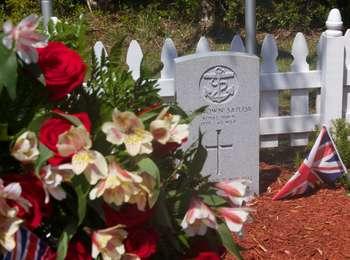Place
Buxton British Cemetery

Historical/Interpretive Information/Exhibits, Parking - Auto, Parking - Boat Trailer, Parking - Bus/RV
During the first six months of 1942, the nearby beaches revealed crude oil, twisted metal, and corpses from the Atlantic Ocean. The grisly flotsam was evidence of World War II's toll imposed by German U-boats. Two foreign sailors who lost their lives during this time are buried in this cemetery. The Commonwealth War Graves Commission, established by Royal Charter in 1917, marks and maintains the war graves of Australia, Canada, India, New Zealand, South Africa and the United Kingdom no matter where they lie.
Every year, the National Park Service, the US Coast Guard, and the British Royal Navy have a ceremony at the site to honor the men who lost their lives in the attacks.
Operation Paukenschlag
On December 7, 1941, the Japanese surprise attack on Pearl Harbor thrust the US unexpectedly into active hostilities. It also compelled Germany's dictator, Adolf Hitler, to declare war on the US.
This declaration brought about a secret plan-code-named Operation Paukenschlag (English translation: Operation Drumroll)-for a swift, decisive submarine assault on the American eastern seaboard. The strategy, conceived by German Rear-Admiral and U-boat commander Karl Donitz, was to take advantage of poor American war preparations and strike at the vulnerable, merchant-rich sea lanes just off the Atlantic coast.
Initially, only five submarines were assigned to the operation, and as they began their stealthy voyage across the Atlantic in late December 1941, not even Admiral Donitz could foresee the success that these few U-boats would achieve.
Paukenschlag Response
A storm was approaching the US, which they were ill-prepared to weather. Naval patrol vessels assigned to the Atlantic were few in number, and those available were obsolete, slow, unseaworthy, or totally inappropriate for anti-submarine duty.
Only one ship, the 165-foot cutter Dione, patrolled the crucial 5th Naval District-a huge section of ocean which included the waters off Cape Hatteras. Designed during Prohibition to thwart rum-runners, the Dione was a fine US Coast Guard vessel. Alone against tested German U-boats, however, she was simply overmatched.
Every year near the anniversary of the HMT Bedfordshire 's sinking, members of the National Park Service, US Coast Guard, and British Royal Navy join visitors and local citizens to honor the service of the men buried in the cemeteries. Officers place wreaths at the graves and local citizens read the names of the dead. The sounding of Taps and a 21-gun salute conclude the memorial services every year.
